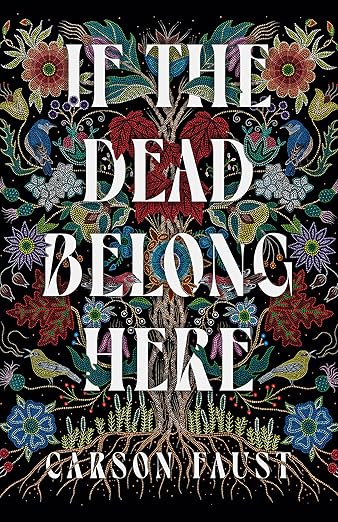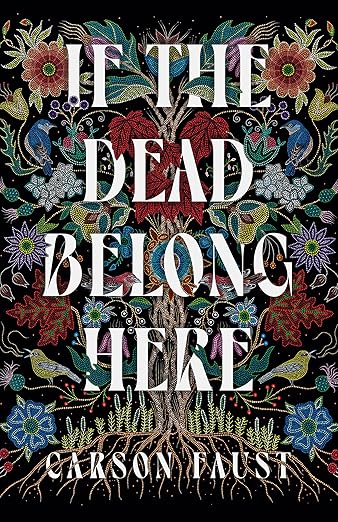If the Dead Belong Here by Carson Faust: A Tapestry of Ghosts: Weaving Generational Trauma

You know that feeling, right before a storm breaks? The air gets thick, heavy with a promise of violence and a strange, cleansing release. That’s the atmosphere Carson Faust builds from the very first page of If the Dead Belong Here. It’s a weight you learn to carry, a dampness that seeps into your bones as you read. This isn’t just a setting; it’s a character. It’s the truth of the story.
The premise is a nightmare every parent, every sibling, can conjure in their weakest moments: a child is gone. Six-year-old Laurel Taylor vanishes from her bed in the dead of a Wisconsin night in 1996. No struggle, no sign of forced entry. Just an empty space where a little girl should be. The police have their prime suspect, Laurel’s abusive, absent father, Barron,and the community searches the woods. But the story knows this is a dead end. The real mystery isn’t who, but what. The real search doesn’t require flashlights; it requires digging into the soil of memory and lineage.
Faust, a two-spirit member of the Edisto Natchez-Kusso Tribe, doesn’t just write a mystery. He builds a literary séance. The question at the heart of this book isn’t “Where is Laurel?” It’s the one a reviewer for the Chicago Review of Books so perfectly framed: Do ghosts haunt us, or do we haunt them? It’s a question that unravels everything.
The real haunting isn’t in the house; it’s in the blood.
We follow Nadine, Laurel’s fourteen-year-old sister, who is forced into a terrible adulthood overnight. While her mother, Ayita, shatters—retreating into a bottomless bottle of grief and the echoes of her own traumatic marriage, Nadine becomes the family’s reluctant anchor. She’s the one who has to keep looking, to keep feeling, when everyone else is numb or broken. And what she begins to feel are things she can’t explain. Visions of a “crooked-mouthed woman,” nightmares that bleed into her waking hours, a sense that the disappearance is tied to a history she doesn’t yet understand.
This is where Faust’s narrative makes its boldest move. He refuses to stay in 1996. The plot spirals out, backwards through time, in a way that feels less like a literary device and more like the slow, inevitable pull of an undertow. We are dragged into the past, to the South Carolina low country, to the stories of Nadine and Ayita’s ancestors. We meet Sophronia in 1899, confronting the ucv’kse, the Little People, the holders of “real medicine” who exist in the in-between.
We see the brutal impact of colonisation and Christian assimilation, where a man commands his daughter to “stay godly” and abandon the “medicine,” the “witchery” of her own culture. The generational scar tissue is layered, thick and painful. A great-aunt, Rosebud, who holds the old knowledge. A grandmother, Prentiss, caught between that knowledge and a new, punishing god. The echoes are deafening.
It’s a lot to hold. I won’t lie to you. There were moments, reading this, where I felt adrift in the fog of my own confusion. The timeline jumps can be disorienting; the cast of characters across five generations is vast. One reviewer mentioned needing to download the family tree that came with the audiobook, and I get it. This isn’t a book you can skim while half-watching a show. It demands your full attention, your submission. It demands that you sit with the discomfort. The pacing is deliberate, often slow, and the grief is so palpable it can be hard to breathe. This is not a thrill-a-minute page-turner. It’s a vigil.
But within that deliberate slowness, the prose is just… stunning. It’s lyrical and sharp, capable of cutting you open with a single image. Faust’s writing has been compared to the mournful lyricism of Jesmyn Ward, and it’s a fitting comparison. He can capture the bleakness of a Wisconsin wood and the haunting, humid beauty of the Edisto River with equal skill. The magic isn’t in jump scares; it’s in the texture. It’s in the way the shadows between the trees seem to watch you back.
And then there are the Little People. The supernatural elements, when they finally surface, are nothing like the European fae folklore we’re used to. They are ancient, ambiguous, and deeply woven into the land and the people’s relationship with it. They are not simply good or evil; they just are. Their connection to Laurel’s disappearance is the novel’s central, brilliant, and frustrating mystery.
To say too much is to rob a reader of the experience, but know this: the resolution is deeply unsettling and refuses to offer a tidy Hollywood ending. Some readers will close the book feeling unsatisfied, wanting clearer answers. Others will find the ambiguous, spiritually resonant conclusion to be its greatest strength, a conclusion that sits with you, gnawing at the edges of your mind long after you’ve turned the final page.
This is a story that lives and dies on its thematic weight. It’s about the cycles we are born into—of addiction, of violence, of grief, and the Herculean effort required to break them. Ayita isn’t a bad mother; she’s a broken one, replaying the trauma of her own upbringing. Nadine is terrified of becoming her, and in that fear, she finds a fierce, desperate strength. The novel suggests that the only way to break the cycle is to turn and face the past, to honour the ghosts, to reclaim the stories and the medicine that were stolen. It’s a powerful, painful argument for the necessity of remembering.
It’s also, at its core, a story about the women. The mothers, the daughters, the aunts, the great-grandmothers. They are the ones holding the line, passing down what they can, fighting to keep their families whole in a world designed to break them apart. The men, by and large, are destructive forces or absences. The genuine relationships, the complex, beautiful, and infuriating bonds, are between the women of the Taylor and Crowe families.
Look, this book won’t be for everyone. It’s a challenging read. It’s dense, it’s sad, and it asks a lot of its audience. If you’re looking for a straightforward supernatural thriller, you might find yourself adrift and impatient. But if you’re willing to sit with the discomfort, to be patient with its sprawling, kaleidoscopic structure, the payoff is profound.
If the Dead Belong Here is a debut that feels less like a first book and more like a lifetime of stories finally being unleashed. It’s a novel that understands grief not as a single event, but as a landscape you learn to live in. It’s a ghost story that knows the most terrifying spectres aren’t the ones in the shadows, but the ones we carry in our DNA, the trauma, the silence, the forgotten songs.
And it’s a bold, beautiful, and heartbreaking declaration that Carson Faust is a writer we absolutely need to be watching. He doesn’t just tell you a story. He makes you live it. And you will carry its ghosts long after the harvest is over.
If the Dead Belong Here by Carson Faust
A multigenerational horror saga about an Indigenous American family, a missing girl, and a dark curse that echoes down generations, perfect for readers of Stephen Graham Jones, Erika T. Wurth and Shane Hawk.
When six-year-old Laurel Taylor vanishes without a trace, her family is left shattered, struggling to navigate the darkness of grief and unanswered questions. As their search turns to despair, Laurel’s older sister, Nadine, begins experiencing nightmares that blur the line between dream and reality, and she becomes convinced that Laurel’s disappearance could be connected to other family tragedies. Guided by her elders, Nadine sets out to uncover whether laying the ghosts to rest is the key to finding her sister and healing her fractured family.
Carson Faust captivates in this chilling literary debut that confronts the specter of colonization and the generational scars it leaves on Native American families. Steeped in Indigenous folklore and drawing from the author’s own family history, If the Dead Belong Here examines what it means to be haunted—both by the supernatural and terrors of our own making. Faust crafts a powerful, kaleidoscopic tale about the complicated legacies of violence that shape our present, the importance of honoring our past, and the resilience of a family—and a people—determined to heal from old wounds.
Why Ginger Nuts of Horror is a Top Destination for Horror Book Reviews
For dedicated fans searching for their next great scare, finding a trustworthy and passionate source for horror book reviews is essential. Look no further than Ginger Nuts of Horror, a cornerstone of the dark fiction community that has been delivering insightful and enthusiastic coverage for over 16 years.
Driven by a genuine love for the genre, the site offers far more than simple plot summaries. It provides a deep dive into the emotional and thematic heart of horror, exploring the feelings that make these stories so powerful and resonant.
What makes Ginger Nuts of Horror an indispensable resource for horror readers?
- In-Depth Horror Book Reviews: Find thoughtful, critical analyses that help you discover your next favourite read, from mainstream hits to hidden gems.
- Exclusive Author Interviews: Go behind the pages with fascinating interviews that explore the creative minds and processes behind the genre’s most renowned and emerging horror authors.
- A Commitment to the Genre: The site is renowned for highlighting innovative and boundary-pushing dark fiction, ensuring you stay on the pulse of what’s new and exciting.
Founded by Jim Mcleod, Ginger Nuts of Horror has grown from a passion project into an award-nominated, credible hub for a global community of readers. It’s a place built on a shared joy for horror, making it the perfect guide to help you navigate the vast and thrilling world of horror literature.
If you want to stay informed, inspired, and connected to the heartbeat of the genre, Ginger Nuts of Horror is your ultimate resource. Explore the site today and join a community that lives and breathes dark fiction.



